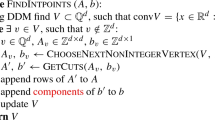Abstract
This paper proposes two algorithms for solving geometric constraint systems. The first algorithm is for constrained systems without loops and has linear complexity. The second algorithm can solve constraint systems with loops. The latter algorithm is of quadratic complexity and is complete for constraint problems about simple polygons. The key to it is to combine the idea of graph based methods for geometric constraint solving and geometric transformations coming from rule-based methods.
Similar content being viewed by others
References
Gao, X. S., Automated geometry diagram construction and intelligent CAD, in Automated Deduction in Geometry, 1999, Berlin: Springer-Verlag, 232–257.
Fudos, I., Hoffmann, C. M., A graph-constructive approach to solving systems of geometric constraints, ACM Transactions on Graphics, 1997, 16(2): 179.
Owen, J. C., Algebraic solution for geometry from dimensional constraints, in Proc. 1st Symp. Solid Modeling Foundations & CAD/CAM Applications, New York: ACM Press, 1991, 379–407.
Latheam, R. S., Middleditch, A. E., Connectivity analysis: a tool for processing geometric constraints, Computer Aided Design, 1994, 28(11), 917.
Yuan, B., Sun, J. G., A graph based approach to design decomposition, The Sixth International Conference on CAD & CG, Dec. 1999, Shanghai-China, 984–988.
Gao, X. S., Chou, S. C., Solving geometric constraint systems I. A global propagation approach, Computer-Aided Design, 1998, 30(1): 47.
Lee, J. Y., A 2D Geometric constraint solver for parametric design using graph reduction and analysis, Automated Deduction in Geometry, New York: Springer-Verlag, 1999, 258–274.
Kramer, G., Solving Geometric Constraint Systems, New York: MIT Press, 1992.
Verroust, A., Schonek, F., Roller, D., Rule-oriented method for parameterized computer-aided design, Computer-Aided Design, 1992, 24(2): 531.
Joan-Arinyo, T., Soto-Riera, A., Combining constructive and educational geometric constraint-solving techniques, ACM Trans. on Graphics, 1999, 18(1): 35.
Ge, J. X., Chou, S. C., Gao, X. S., Geometric constraint satisfaction using optimization methods, CAD, 1999, 31(14): 867.
Heydon, A., Nelson, G., The juno-2 constraint-based drawing editor, SRC Research Report 131a, 1994.
Lamure, H., Michelucci, D., Solving geometric constraints by homotopy, IEEE Trans., on Visualization and Computer Graphics, 1996, 2(1): 28.
Light, R., Gossard, D., Modification of geometric models through variational geometry, Geometric Aided Design, 1982, 14: 208.
Gao, X. S., Chou, S. C., Solving geometric constraint problems, II. A symbolic approach and decision of Rc-constructibility, Computer Aided Design, 1998, 30(2): 115.
Kondo, K., Algebraic method for manipulation of dimensional relationships in geometric models, Geometric Aided Design, 1992, 24(3): 141.
Hoffmann, C. M., Lomonosov, A., Sitharam, M., Finding solvable subsets of constraint graphs, LNCS, 1997, (1330): 163.
Chou, S. C., Mechanical Geometry Theorem Proving, Dordrecht: D. Reidel Publishing Company, 1988.
Chou, S. C., Gao X. S., Zhang, J. Z., Machine Proofs in Geometry, Singapore: World Scientific, 1994.
Wu, W. T., Toward mechanization of geometry—Some comments on Hilbert’s “Grundlagen der Geometrie”, Acta Math. Sci., 1982, 2: 125.
Wang, D., On Wu’s method for proving constructive geometric theorems, in Proc. IJCAI 89 (Detroit, August 20–25, 1989), 1989, 419–424.
Chou, S. C., Gao, X. S., Zhang, J. Z., Automated generation of readable proofs with geometric invariants, I. Multiple and shortest proof generation, J. of Automated Reasoning, 1996, 17: 325.
Li, H. B., Cheng, M. T., Automated ordering for automated theorem proving in elementary geometry, MM-Preprints, 1999, (18): 84.
Chou, S. C., Gao, X. S., Zhang, J. Z., Machine Proof in Geometry, Singapore: World Scientific, 1994.
Wang, D., Reasoning about geometric problems using an elimination method, In Automated practical reasoning: Algebraic approaches (eds. Pfalzgraf, J., Wang, D.), New York: Springer Verlag, 1995, 147–185.
Dong, J. X., Ge, J. X., Gao, Y. et al., New ideas for constraint solving in parametric drawing systems, CAD and Graphics, 1997, 9(6): 513.
Wu, W. T., Basical principles of mechanical geometry theorem proving, New York: Springer-Verlag, 1994.
Chen, L. P., Tu, C., Luo, H., and Zhou, J., A New parametric oriented drawing technique, Ruanjian Xue-Bao (in Chinese), 1996, 7(7): 394.
Wu, W. T., A mechanization method of geometry and its applications I. Distances, areas, and volumes, J. Sys. Sci. and Math. Scis., 1986, 6: 204.
Author information
Authors and Affiliations
Corresponding author
Rights and permissions
About this article
Cite this article
Gao, X., Huang, L. & Jiang, K. Geometric constraint solving with geometric transformation. Sci China Ser F 44, 50–59 (2001). https://doi.org/10.1007/BF02713939
Received:
Issue Date:
DOI: https://doi.org/10.1007/BF02713939




